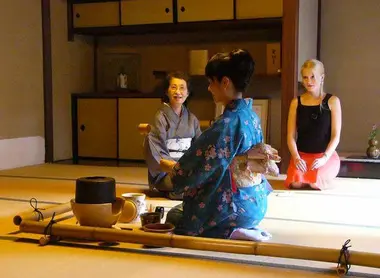Raku ceramics 楽焼
An art in the service of tea
Raku ceramics are distinguished by their irregular and sometimes even austere appearance. This simplicity devoid of the ceremonial display makes it an essential part of the tea ceremony.
It was in the 16th century, in the districts of Kyoto, that Raku ceramics made their appearance. If at first, the production was centered on tea bowls, it diversified over the years. This style is today largely used for making various objects.
Chinese ancestor
Chôjirô is busy behind the doors of his workshop, surrounded by the ambient heat of his oven. Under the orders of the grandmaster of tea Sen no Rikyu, he made a series of tea bowls using the Raku technique. The result? Imperfect bowls, with a raw appearance as if weathered by time, sometimes enhanced with metallic reflections. Raku-yaki is an adaptation in two colors (black and red) of the Sancai technique, used in China since the Tang dynasty (618–907). It is said to have been brought back to Japan by Chojiros father. If the Sancai ceramic displays three colors (green, brown, red), the raku type offers an object of greater aesthetic simplicity.
Read also: Choosing and buying ceramics in Japan
Thermal shocks
The particularity of Raku ceramics is first of all due to its manufacture. In the workshop, you will not find any potter's wheel because the shaping is entirely done by hand. The cooking mode is also specific. The bowls are extracted from the oven, the temperature of which rises to 980 degrees Celsius, using long tongs. This first thermal shock gives a cracked appearance to the pottery. Still warm, it is covered with plants or woodchips until its temperature drops to around 500 degrees Celsius.
Singular works
To finish, the bowl is plunged into cold water to stop the cooking and fix the colors. This succession of thermal shocks gives its identity to raku ceramics, simple, irregular pottery where each object is unique because it is subject to the slightest variations over time. of its manufacture (weather, fuels used). This is certainly the reason why Sen no Rikyû made Chojiro the first producer of raku bowls, intended for the tea ceremony.
To read: The Touki Ichi ceramics fair in Kyoto
The zen spirit
Indeed, by its appearance, raku ceramic embodies all the subtleties of the codes of the tea ceremony and by extension of wabi-sabi: an aesthetic concept derived from Zen philosophy. The term wabi refers to simplicity, discretion, and elegance; as for that of sabi, it evokes nature, the raw aspect of things, the effect of passing time, imperfection. Thus, the wabi-sabi illustrates a sensitive "beauty" that can move those who listen, look, touch. Choosing your raku ceramic is therefore a matter of personal experience: observation and handling of the object will guide your choice.
To find out more about this fine example of Japanese know-how and craftsmanship, visit the Raku Ware museum, next to the Raku family's house and workshop, in Kyoto. You will then be able to discover the most representative pieces of this generation of famous potters and the utensils associated with the tea ceremony.
Also to be discovered near Kyoto: Shigaraki ceramics
Raku Ware Museum, 84 Aburanokōji Nakadachi-uri agaru, Kamigyo Ward, 602-0923, Kyoto; 10 am to 4:30 pm; closed on Mondays.




















